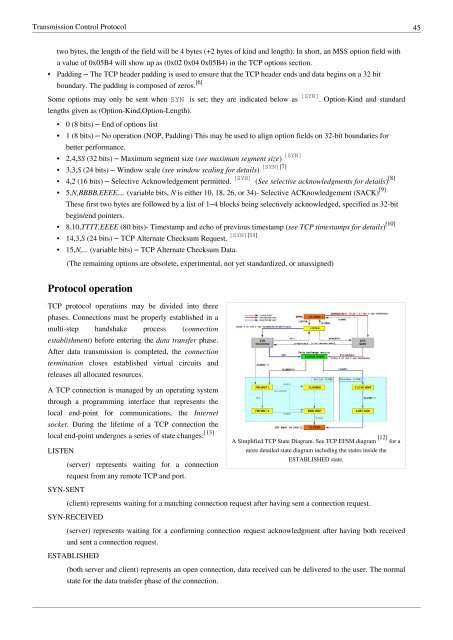Internet Protocol - Research by Kirils Solovjovs
Internet Protocol - Research by Kirils Solovjovs
Internet Protocol - Research by Kirils Solovjovs
Create successful ePaper yourself
Turn your PDF publications into a flip-book with our unique Google optimized e-Paper software.
Transmission Control <strong>Protocol</strong> 45<br />
two <strong>by</strong>tes, the length of the field will be 4 <strong>by</strong>tes (+2 <strong>by</strong>tes of kind and length). In short, an MSS option field with<br />
a value of 0x05B4 will show up as (0x02 0x04 0x05B4) in the TCP options section.<br />
• Padding – The TCP header padding is used to ensure that the TCP header ends and data begins on a 32 bit<br />
boundary. The padding is composed of zeros. [6]<br />
Some options may only be sent when SYN is set; they are indicated below as [SYN] . Option-Kind and standard<br />
lengths given as (Option-Kind,Option-Length).<br />
• 0 (8 bits) – End of options list<br />
• 1 (8 bits) – No operation (NOP, Padding) This may be used to align option fields on 32-bit boundaries for<br />
better performance.<br />
• 2,4,SS (32 bits) – Maximum segment size (see maximum segment size) [SYN]<br />
• 3,3,S (24 bits) – Window scale (see window scaling for details) [SYN][7]<br />
• 4,2 (16 bits) – Selective Acknowledgement permitted. [SYN] (See selective acknowledgments for details) [8]<br />
• 5,N,BBBB,EEEE,... (variable bits, N is either 10, 18, 26, or 34)- Selective ACKnowledgement (SACK) [9]<br />
These first two <strong>by</strong>tes are followed <strong>by</strong> a list of 1–4 blocks being selectively acknowledged, specified as 32-bit<br />
begin/end pointers.<br />
• 8,10,TTTT,EEEE (80 bits)- Timestamp and echo of previous timestamp (see TCP timestamps for details) [10]<br />
• 14,3,S (24 bits) – TCP Alternate Checksum Request. [SYN][11]<br />
• 15,N,... (variable bits) – TCP Alternate Checksum Data.<br />
(The remaining options are obsolete, experimental, not yet standardized, or unassigned)<br />
<strong>Protocol</strong> operation<br />
TCP protocol operations may be divided into three<br />
phases. Connections must be properly established in a<br />
multi-step handshake process (connection<br />
establishment) before entering the data transfer phase.<br />
After data transmission is completed, the connection<br />
termination closes established virtual circuits and<br />
releases all allocated resources.<br />
A TCP connection is managed <strong>by</strong> an operating system<br />
through a programming interface that represents the<br />
local end-point for communications, the <strong>Internet</strong><br />
socket. During the lifetime of a TCP connection the<br />
local end-point undergoes a series of state changes: [13]<br />
LISTEN<br />
SYN-SENT<br />
(server) represents waiting for a connection<br />
request from any remote TCP and port.<br />
A Simplified TCP State Diagram. See TCP EFSM diagram [12] for a<br />
more detailed state diagram including the states inside the<br />
ESTABLISHED state.<br />
(client) represents waiting for a matching connection request after having sent a connection request.<br />
SYN-RECEIVED<br />
(server) represents waiting for a confirming connection request acknowledgment after having both received<br />
and sent a connection request.<br />
ESTABLISHED<br />
(both server and client) represents an open connection, data received can be delivered to the user. The normal<br />
state for the data transfer phase of the connection.


